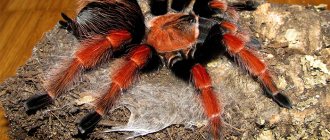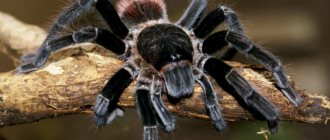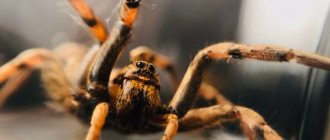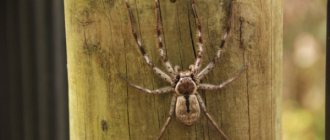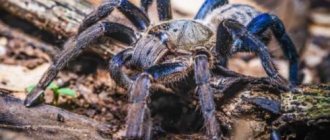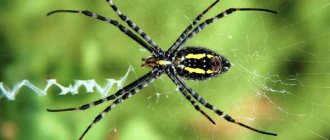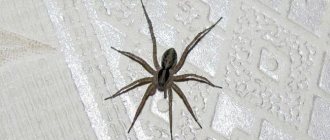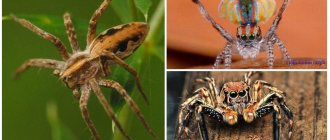House insects and spiders can be interesting to watch. They are very quiet, clean pets that do not need much space to live.
Insects and spiders also don't require much attention or socialization (in fact, they usually do best with small interactions).
However, before you choose an insect or spider as a pet, consider why you want the pet. If you're just looking for a unique or "cool" pet, or a pet to impress or shock your friends, think again.
Insects and spiders are unique and while they are not overly demanding of their care, you should make the same level of commitment to caring for them as you would any other pet.
Too many owners get spiders in their home on impulse, and once the novelty wears off, they become tired of caring for them.
How to make the right choice?
Terrestrial spider species are the best choice for beginners. They are less demanding in maintenance and much slower than woody ones. The best ones to pay attention to are the following species: Lasiodora parahybana, Brachypelma boehmei, Brachypelma albiceps, Brachypelma smithi. In general, the entire genus Brachypelma is considered one of the best for beginners. They are quite calm and their venom is less toxic than that of other species. If you want to get a tree spider, it is worth remembering that you need to be extremely careful with them, as they are capable of moving very quickly.
Methods for handling the tarantula
Before you pick up a tarantula spider, you must understand that these are not domestic animals that you can carry around at will. Competent and safe handling of a spider comes to you with experience, along with appropriate knowledge of all the intricacies and behavior of your animal. Be confident in yourself and your abilities. In the event of an unexpected bite, you instinctively throw it away from you. In this case, the spider will be frightened and will be in a state of shock, and this will lead to death for the spider itself. To avoid such unpleasant situations, you need to know the following:
1. Don't scare people with your pet.
2. Be extremely careful and be prepared for anything when you want to pick up a spider.
3. no sudden movements so as not to provoke an attack or defense.
4. You should not blow on the spider, so that the spider does not make a sharp jerk in front.
It would not be the best idea if you get a tarantula just to stand out or make a general impression on your family and friends, since such rash decisions can lead to quite unpleasant events. Eg:
- your pet may bite you
- due to contact with the protective hairs, an unpleasant itching occurs that will last for several days in the place where you came into contact with it, unless of course you thought to wash your hands with cold running water. Consequences: If you are not ready for contact with a spider, do not expect the tarantula to calmly fall into your hands. This may encourage biting or restless behavior. I do not recommend carrying out this manipulation with any New World spider unless it has an abnormally calm temperament. Otherwise, as a consequence, you will get a dose of protective hairs on your palm. Especially if you are prone to hypersensitivity. But still the choice is yours. So we will tell you about 3 main methods for picking up a spider.
1. Method "Death Grip":
Description of steps 1) Depending on where the tarantula is located: on the ground, in the grass, it is worth remembering what needs to be done to minimize injury to the spider. 2) Stop the tarantula's movement by gently pressing the shell with your index finger, and curl the rest into a fist for your safety. Monitor the spider's behavior so that you can respond to its aggressive behavior in time. If he goes into a defensive posture after this, this is an indication that this method of application is not suitable for your spider.
3) Once the tarantula has stopped moving, cover it with your hand to prevent it from running away or becoming defensive. Remember that it is better for you to be sure, if the spider does not like this and manages to turn it over on its back and it wants to bite you, we advise you to stop this procedure and return the tarantula back to the terrarium.
4) Turn your hand and grab the tarantula by its sides, do not do this very quickly so that you do not scare the tarantula.
5) You want your hand to be positioned carefully before lifting your beast, without squeezing it too tightly. If your tarantula is on a carpet or other similar surface, the spider will most likely cling to the fibers when you lift it, but do not tear the spider off the surface very quickly. This can cause serious damage to the spider. Just take your other hand and touch the spider’s legs or you can lift them a little, this will help you, the spider will hide its “claws” and release the fibers. If you pick it up from the terrarium, make sure it doesn't get caught on anything.
6) Congratulations if you have made it this far. You have successfully mastered this “Death Grip” method. If you want to return the tarantula back to the container, simply lower it onto the ground. If the spider has no place to hide, be prepared for the fact that the tarantula may become defensive to show you its power. They often wait for the right moment to bite you.
Advantages:
- The tarantula spider will not be able to escape and bite you.
Flaws:
- You should not use this method for tarantula spiders that have irritable hairs; it is best to wear gloves for protection.
2. Crab Grip Method:
Technically, this is when you grab the tarantula between the 2nd and 3rd pairs of legs by grabbing it by the cephalothorax, although it may not like it. This method is used by many people to determine the sex or simply transplant the spider. In many textbooks and various literature, this method is recommended as the most suitable, but many do not agree with this. It is only suitable for large spiders, new world, and is very risky for tarantulas with medium to high venom levels.
Advantages:
- This method is probably best for those who select their own tarantulas.
Flaws:
— The method can be dangerous for you and your tarantula. A tarantula can easily bite you.
3. Easy Walk Method:
Tarantula spiders, scorpions and other arthropods never “bite” the surface they are on, for example a hand. Therefore, you can safely use this method without worrying about bites. The most important thing is to leave all your fears so that there are no trembling hands.
Basic techniques:
- When the spider crawls, just place your hand for it to climb onto.
- If the tarantula is stationary, push it slightly from behind with its brush or hand so that it can climb onto your hand.
Advantages:
This method is good if you are afraid of irritating hairs.
Flaws:
- The tarantula can fall from your hand, and if the height is high, the spider can get injured.
- If the spider is hungry, when the hand shakes, it will mistake it for food and try to attack. If the article helped you, give it 5 stars, friends! 
Brief description and appearance features
The tarantula has a bright, unusual appearance that attracts the eye. The average size of arthropods varies from 8 cm to 30 cm.
Spiders are covered with fur, which makes them look like a plush toy.
A particularly notable feature is the color. Most tarantula spiders are characterized by brownish or black and white colors. Blue insects are less common. The belly is orange, and the paws stand out thanks to their blue or bright yellow coloring.
The external features of the tarantula spider are largely determined by its species, of which there are a huge number.
Where are spiders kept?
The best place for spiders to live in a house is considered to be a terrarium made of plastic or glass. The container must be hermetically sealed, but at the same time have good ventilation.
On a note! To create ideal living conditions, it is extremely important to know the natural living conditions of the selected spider - how long the pet will live depends on this.
The size of the terrarium depends on the size of the pet itself. For a young spider that has only survived a few molts, you can use a plastic container measuring 6x8x10 cm as a house, and for an adult tarantula you need a terrarium measuring 30x30x30 cm. It is better not to use large containers - the pet will feel discomfort in them.
Terrarium
Only one individual can be kept in one container. The babies are kept together until the first moult, and then they also need to be seated, otherwise injury and death of the pets may not be avoided.
Before you move your pet in, you need to properly prepare its house:
- Spiders need moisture to thrive. To do this, you need to periodically moisten the substrate through a watering can or syringe without a needle (but not with a spray). In this case, moisture should not get on the pet.
- There should be a layer of substrate at the bottom.
- Ventilation and tightness. This means that the container must close well, but at the same time air must flow freely into it. To do this, you need to have a terrarium with small multiple holes on the lid.
- Tarantulas do not need lighting - they are nocturnal inhabitants.
- Tarantulas are not too picky about temperature indicators, but it is best if the temperature in the house is maintained at +22…26 °C.
Who can be kept at home
Recently, keeping spiders has become accessible and simple. You can choose several types.
Tarantula
A large selection of tarantula subspecies allows you to choose the ones you like. They come in hairy, hairless and even two-tone varieties. The horned and striped subspecies are unusual.
Tarantula
The lifespan of females of this species of spider is up to 30 years. Such cohabitation can last for a long time. They are unpretentious, temperamental and there is a wide choice for purchase.
Cross
Rearing can be problematic because females and males have different life expectancies. They need “summer” conditions all year round and enough free space.
Wolf
Solitary predators wandering around their territory are good hunters. They can wander into people's houses and, in case of danger, bite, but do not cause much harm.
Jumpers
A large family, among whose representatives pets can be chosen. Some of them are small and even cute. There are those that imitate ants and insects.
Spiders and a warm attitude towards them
Hand spider.
Pets are kept for love and warm feelings. But these pets will not appreciate displays of tenderness. Spiders may react in different ways:
- bite under stress;
- accidentally being injured;
- changes in temperature and humidity can be scary;
- the spider might just run away.
What to do if you are bitten
If safety measures were violated, you really wanted to touch the spider and the result was disastrous, first aid must be provided.
The types of spiders living in the house are not poisonous, but the bite is at least unpleasant. Necessary:
- Pull the limb above the bite site to prevent the poison from spreading.
- Wash the area with soap and treat with an antiseptic.
- Apply ice to relieve itching.
- Drink plenty of water to remove poison.
Diseases treatment and prevention
Diseases of tarantula spiders are not well studied. Most often, health problems with a furry pet are caused by unsuitable living conditions, for example, low temperature or insufficient humidity.
A tarantula can be injured if it falls from a height, so you should not choose a terrarium that is too high for your pet.
Another problem is mites that parasitize the spider’s body or infect its lungs, as well as nematodes. To prevent the appearance of parasites, it is necessary to maintain the cleanliness of the substrate and the terrarium itself.
How long does a tarantula live in captivity?
The lifespan of different species of tarantulas when kept in captivity varies greatly. For example:
- arboreal species and tarantulas belonging to the genus Pterinochilus - no more than 7-14 years;
- all large terrestrial species - about 20 years.
Males mature earlier than females, at about a year and a half, so most often the average life expectancy of a male tarantula after the last molt does not exceed six months. However, so-called long-lived males who have lived for long periods of time are also known:
- males of Grammostola rosea – one and a half years;
- males Megarobema velvetosoma – nine months;
- males Poecilotheria formosa - about 11 months;
- males of Poecilotheria ornata – a little over a year;
- males Poecilotheria rufilata - approximately one and a half years.
A unique and rare case has been recorded in which a captive male arboreal tarantula Poecilotheria regalis was successfully able to molt a couple of times with a month and a half interval between molts
Reproduction
The sex of a tarantula spider is easy to determine if you follow the recommendations of experts. Young spiders begin to molt after about a month. After molting, the skin is taken and carefully examined. In the posterior region of females there is a depression, and in males there are something like two tubercles. If the individuals are adults, then the sex can be determined by appearance. Males have slightly slimmer legs and are taller, while the body is significantly smaller in size than the female.
After mating, the eggs develop inside the female for 2 months. During this period, she must form a special cocoon. At one time, she can lay up to 500 eggs, while about 50 spiders remain alive. In order for the juveniles to actively develop, the cocoon is moved to a separate terrarium, thereby creating certain temperature conditions.
For the first month, baby spiders do not eat anything, until the first molt. Until this moment, they can be together, after which they are separated one by one. A female tarantula spider molts up to 12 times during her entire life. Males stop moulting immediately after puberty.
Interesting to know ! The tarantula spider is constantly growing and maturing, which is why it needs to shed its “old clothes”. Before molting, individuals turn over on their backs, trying to remove their old skin. At the same time, he completely stops eating. After molting, the spider gets a new color, and the pile is completely renewed.
Conditions for keeping spiders
Arthropods do not need much space to roam; most representatives quietly spend their time in a hole or hollow. But there are a number of conditions that will need to be taken into account. Here's what you'll need to keep a spider:
- capacity;
- filler;
- drinking bowl;
- thermometer;
- decor;
- lighting;
- brush;
- insulation box.
Dimensions
The minimum is twice the distance of the animal’s leg span. Not high so that it does not break when hit.
Substrate
For comfort and maintenance of convenience, filler is needed. It can be coconut or vermiculite.
Sealing
Any place that will be a home must have a cover so that the spider does not have the opportunity to walk around the house on foot.
Ventilation
While you need a sealed terrarium, you must not forget that the spider needs fresh air. If there are no holes in the container, they need to be made.
Shedding
The amount of lighting depends on the type of spider. Some residents do not need lighting and can navigate in the dark, while others like to sunbathe.
Temperature
There is a general indicator of 23-26 degrees. But in cold weather, additional heating may be required and, accordingly, vice versa.
Humidity
It should be in moderation. The spider may have behavioral indicators - it will either drag the drinker into the hole or sit on the walls.
Setting up a terrarium
In order for your new pet to live happily ever after, no special conditions are required - a modest terrarium is quite enough. Spiders are gloomy ascetics and spend most of the time allotted for themselves sitting in one place, only occasionally making “jogs” to stretch their legs. A cozy spider house with optimal dimensions is a terrarium equal to two lengths of the full span of its legs, that is, even the largest spider will feel great in a living space of 40x40cm.
But do not forget that spiders can move quite well on vertical surfaces, so the main thing is a reliable lid that will close well and keep the poisonous pet in its rightful square centimeters.
Let's move on to creating optimal conditions for the spider.
- Substrate. It is necessary to “cover the floor” in the spider’s home with a special flooring. The ideal option is vermiculite, a special mineral rock that is used in crop production. Layer - from 3 to 5 cm. If you can’t find one, you can also use coconut substrate or regular peat. By the way, it is recommended to mix the latter with sphagnum moss. As a last resort, when there is absolutely nothing, garden soil will do (only from a flower shop and in no case from the nearest flower bed!) or soil used for growing indoor plants. However, it is advisable to use this option for a short time and try to quickly replace it with a substrate more suitable for the spider.
- Temperature. Spiders are thermophilic and prefer to stay in a temperature range that will be close to +22…28°C. These pets are immune to a slight short-term decrease in temperature, but it is undesirable to abuse such situations. But at the same time, it is not recommended to overheat the terrarium. This situation is especially dangerous for well-fed animals, in which the process of rotting undigested food may begin in the stomach.
- Lighting. For spiders, which are nocturnal inhabitants, the natural light in the room is sufficient. No additional sources are needed. Moreover, direct light from a lamp can quickly destroy this fragile creature.
- Humidity. A drinking bowl and the right substrate help to some extent to ensure its optimal level. If the readings on the hygrometer are too low, then from time to time you will have to irrigate the terrarium with water from a spray bottle. But again, high humidity is dangerous, so when buying a spider, immediately find out from the seller what humidity is needed specifically for this species.
- Filling. For a spider in a terrarium, the main thing is a shelter in which it can hide during daylight hours, and if you keep a burrowing species, then a “house” is simply a must for it. Without it, such a pet will be in constant stress. Setting up such a shelter is very simple - you can lean a piece of bark, a coconut shell against the wall, put an inverted half of a flower pot in the corner, etc. Everything else, such as decorative driftwood, artificial plants and other similar elements, is unnecessary. Spiders are completely indifferent to them, so you purchase and install such accessories exclusively for yourself.
Requirements for keeping a spider at home
When all stages of preparation are completed, you need to arm yourself with knowledge about the features of caring for an exotic pet.
Nutrition
Feeding of the tarantula spider.
Spiders are mostly predators. For food they choose various cockroaches, larvae, flies and worms. They are bought in special stores.
It is better not to feed your pets the bugs that are caught in the house. They may be sick or carrying an infection. Moreover, some food may be unusual and difficult for the spider.
The amount of food is selected depending on the size and age of the exotic. Usually young ones are fed 3 times a week, adults 1-2 times. Food is served with tweezers, do not overfeed and remove leftovers after eating.
Cleaning
If you remove leftover food in a timely manner, there will be no need for frequent cleaning. Depending on the size and substrate, it will need to be removed every 9-12 months. The spider is pushed towards the container in which it will stay and the substrate is replaced.
Keeping a spider at home.
Shedding
Spider after molting.
When a spider begins to molt, it becomes especially vulnerable. It’s easy to understand the onset - the pet stops eating and moves little. Some lie on their backs, while others make a nest for themselves out of cobwebs. It goes like this:
- the spider begins the process under the influence of hormones;
- the old skeleton is slowly peeling off;
- do not touch the young one until it hardens;
- You can’t help the spider, not even touch it;
- When the pet is firmly on its feet, you can remove the old skeleton.
A young animal tolerates molting faster and easier. If it does not occur for a long time, then it may be necessary to adjust the conditions.
Reasons to have a pet spider:
- Getting to know the view. It is extremely rare for people to voluntarily begin to observe spiders on the street or those that appear in houses without asking. In addition, they are quite cautious, and therefore immediately try to hide when a person approaches. Thus, a house spider is a great way to get to know these creatures and their way of life.
- Small investment of time and money.
- Does not cause the same inconvenience as cats or dogs (tufts of fur on furniture, need to walk, etc.).
- A good option for a pet in a rented apartment is if the landlord prohibits having animals.
- A house spider can help overcome arachnophobia.

